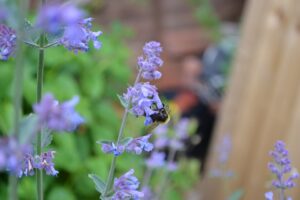How to Grow and Care for Catmint

Native to southern and eastern Europe parts of China, Central Asia, and the Middle East the catmint plant can be found growing in many home gardens and landscape. This herbaceous perennial thrives in zones 3-7 attracting bees, butterflies, and birds.
The catmint grows to about 3 feet with 2 feet spread and is taught to have been cultivated in the Roman town of Nepeti. The catmint belongs to the family Lamiaceae and is commonly known as catwort or catswort. This aromatic herb will go to work for you, for more on the growth and care of catmint continue reading.
The planting location
When installing the catmint, locate an area that gets full to partial sunlight.
The soil type
Many species grow in a wide range of soil however a soil that’s well-drained rich in humus is ideal for proper growth.
Water requirements
When first installed the catmint needs to be watered frequently, once the plant establishes it becomes drought-tolerant.
Fertilizing your catmint
Adding compost to the plant base during the fall months is ideal, other than that there is no need for fertilizer application.
Garden insect pests of catmint
Catmint is basically pests-free and can be grown near vegetable gardens acting as a deterrent or repellent keeping garden pests at bay some of which include squash bugs, aphids, Colorado potato beetles, asparagus beetle, etc…
Disease of catmint
In humid hot conditions, catmint may be affected by Pseudomonas a bacterial pathogen, the use of a bactericide will bring control.
How to prune catmint
Pruning catmint will encourage new growth, pruning should be carried out when it flowers in early spring and summer. Prune faded flowers to the ground, or cut the entire plant back by one-half to two-thirds after it flowers will encourage a fuller healthier plant.
Harvesting catmint
The leaves of catmint can be harvested as soon as the flowers begin to bloom around mid-summer. The ideal time to harvest is during the day hours after the dew has dried to minimize the risk of your harvest becoming moldy. The leaves of the catmint can be used fresh or dried if drying store in an airtight container to preserve freshness.
Growing catmint in containers
A great way to grow catmint is from a container for those of you who have limited space. When growing catmint from a container chose a container large enough for your catmint to sit comfortably. The container/containers should have drain holes for water drainage, once catmint becomes established can survive on very little water because these plants are drought-tolerant. The container should also be located in an area that gets full to partial sunlight.
The use of a potting mix that is well-drained is ideal, if sowing from seeds read the package for instruction. The seeds however can be spaced 12 inches apart and at a depth of ¼ inch, seeds should sprout in 10-20 days. Follow the listed steps above for growing success.
Where to install catmint
1. Catmint can be planted as an edging.
2. Can be planted in masses.
3. Catmint makes a great insect repellent by installing it near a vegetable garden.
The final word on catmint plant care
The catmint has so many benefits that make this plant a good investment, with catmint you get the best of both worlds and then some. I love the idea of having catmint as a part of my garden and landscape design because you can grow catmint for any of the above-listed reasons or maybe all of them. Take advantage of catmints by installing them in your garden and reap the rewards.
About the author
Norman loves being in the garden, both at home and for his job....
he is 'Natures Little helper' being outdoors, growing his vegetables and flowers from an early age.
Now having spent over 22 years in the profession he want to give some of his knowledge to others...
his vast array of hints and tips you will find scattered over this site will help you no end growing plants in your garden.
